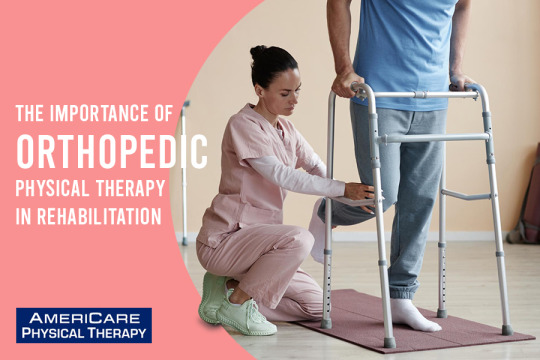#East BrunswickOP/PT Center
Text
The importance of Orthopedic Physical Therapy in rehabilitation

Orthopedic physical therapy stands as a cornerstone in the realm of rehabilitation, offering individuals suffering from musculoskeletal injuries or conditions a pathway towards recovery, functionality, and enhanced quality of life. Rooted in evidence-based practices and specialized techniques, orthopedic physical therapy addresses a broad spectrum of issues ranging from fractures and joint replacements to chronic conditions like osteoarthritis and tendonitis. Its significance lies not only in restoring physical capabilities but also in mitigating pain, preventing further injury, and fostering long-term well-being.
1. Comprehensive Assessment And Individualized Treatment
One of the fundamental aspects of orthopedic physical therapy is its tailored approach to each patient. Warren Orthopedic physical therapists conduct thorough assessments to pinpoint the root cause of dysfunction or pain, considering factors such as medical history, lifestyle, and specific goals. By understanding the unique circumstances of each individual, therapists can devise personalized treatment plans that optimize outcomes.
2. Pain Management And Functional Restoration
Orthopedic injuries often bring with them debilitating pain that hampers mobility and diminishes quality of life. Through a combination of manual therapy techniques, therapeutic exercises, modalities like heat or cold therapy, and patient education, orthopedic physical therapists address pain at its source. By improving joint mobility, strengthening muscles, and enhancing flexibility, patients gradually regain function and independence in their daily activities.
3. Post-Surgical Rehabilitation
Following orthopedic surgeries such as joint replacements, ligament repairs, or spinal procedures, rehabilitation plays a crucial role in ensuring optimal recovery. Orthopedic physical therapists East Brunswick work closely with patients in the post-operative phase, guiding them through exercises and movements that promote healing while minimizing complications. Additionally, therapists educate patients on proper body mechanics and techniques to prevent re-injury, empowering them to navigate their rehabilitation journey with confidence.
4. Prevention And Long-Term Wellness
Beyond treating existing injuries, orthopedic physical therapy emphasizes preventive strategies to reduce the risk of future musculoskeletal problems. By identifying biomechanical imbalances, muscle weaknesses, or faulty movement patterns, therapists can implement corrective exercises and ergonomic recommendations to mitigate potential issues. Moreover, through patient education on lifestyle modifications, injury prevention strategies, and home exercise programs, orthopedic physical therapy fosters a proactive approach to maintaining musculoskeletal health.
5. Holistic Approach To Rehabilitation
Orthopedic physical therapy adopts a holistic perspective that acknowledges the interconnectedness of physical, emotional, and psychological factors in the healing process. Therapists not only address physical impairments but also consider the emotional impact of injuries and the psychological barriers to recovery. By fostering a supportive and empathetic environment, orthopedic physical therapy encourages patients to actively participate in their rehabilitation journey, promoting resilience and overall well-being.
0 notes